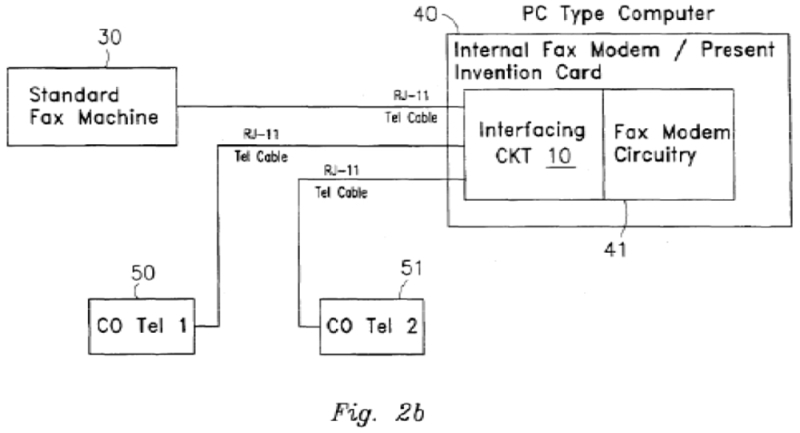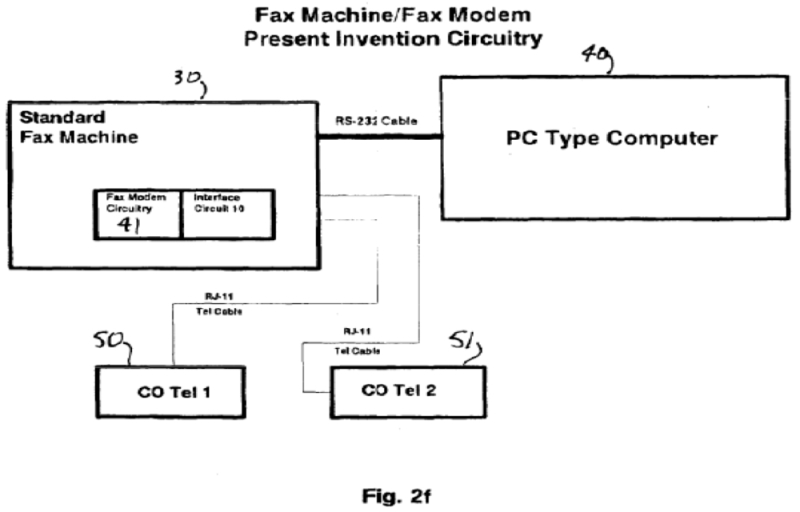Infinity Computer Products ("Infinity") sued Oki Data in the District of Delaware for infringement of four patents. The District Court found the patents invalid due to indefiniteness and the Federal Circuit affirmed. This case serves to illustrate two important points in patent law: (i) taking contradictory positions during prosecution will be held against the applicant, and (ii) the Federal Circuit will take said contradictory positions to an unnecessary extreme in order to support a holding of indefiniteness.
Representative of the Infinity patents is U.S. Patent No. 6,894,811, claim 1 of which recites:
A method of creating a scanning capability from a facsimile machine to a computer, with scanned image digital data signals transmitted through a bi-directional direct connection via a passive link between the facsimile machine and the computer, comprising the steps of:
by-passing or isolating the facsimile machine and the computer from the public network telephone line;
coupling the facsimile machine to the computer;
conditioning the computer to receive digital facsimile signals representing data on a scanned document; and
conditioning the facsimile machine to transmit digital signals representing data on a scanned document to the computer, said computer being equipped with unmodified standard protocol send/receive driver communications software enabling the reception of scanned image signals from the facsimile machine, said transmitted digital facsimile signals being received directly into the computer through the bi-directional direct connection via the passive link, thereafter, said computer processing the received digital facsimile signals of the scanned document as needed.
The '811 patent is a continuation in part of U.S. Patent No. 5,530,558. The emphasized term "passive link" was a point of contention in the suit and ultimately led to the invalidation of all of the Infinity patents.
The claimed invention is directed to "using a fax machine as a printer or scanner for a personal computer." According to the specification, its goal is to "provide a circuit for interfacing a PC and a facsimile to enable the facsimile to be utilized as a scanner or a printer for a PC and to accomplish all of the objectives of a scanner or a printer."
Various embodiments involve this circuit being internal or external to a PC. The internal version, with the circuit integrated into a fax modem, is illustrated in Figure 2b of the '811 patent, reproduced below.
 An alternative embodiment involves the fax modem and circuit being integrated into the fax machine, and the PC connected to the fax machine by way of an RS232 serial cable. This is illustrated in Figure 2f of the '811 patent, also reproduced below. The parent '558 patent does not include Figure 2f.
An alternative embodiment involves the fax modem and circuit being integrated into the fax machine, and the PC connected to the fax machine by way of an RS232 serial cable. This is illustrated in Figure 2f of the '811 patent, also reproduced below. The parent '558 patent does not include Figure 2f.
 During initial prosecution, the examiner cited U.S. Patent No. 5,452,106 ("Perkins") against the claims as anticipatory art. Perkins discloses a similar arrangement in which a PC uses a fax machine as a printer and scanner.
During initial prosecution, the examiner cited U.S. Patent No. 5,452,106 ("Perkins") against the claims as anticipatory art. Perkins discloses a similar arrangement in which a PC uses a fax machine as a printer and scanner.
After a series of amendments, Infinity achieved an allowance by amending the claims as shown above. This involved introducing the aforementioned term "passive link". Notably, this term does not appear in the '811 patent nor does it appear in the parent '558 patent. Nonetheless, Infinity relied heavily on this term and argued:
The Applicant creates a passive link between the facsimile machine and the computer in order to accommodate the signal transfer for printing or scanning. Therefore, the Applicant does not require any intervening apparatus as does Perkins. The applicant therefore believes Perkins did not anticipate the methods used by the Applicant.
Perkins' device 3 or card design requires a modem to be integrated into it in order to transfer signals for scanning or printing as part of his computer and facsimile transceiver interface. In contrast, the Applicant can transfer digital signals between the facsimile transceiver and the computer without the need for a modem at the computer interface.
In making this argument, Infinity relied on the disclosure of Figure 2f, that did not have a modem between the fax machine and the PC. Infinity stated that:
Contrary to the above, when the Applicant transfers digital data from the facsimile transceiver through a passive link for scanning to the computer, the non-intercepted data enters through the RS 232 type connector port of the computer and passes directly to the I/O Bus and is processed by the receiving circuits (i.e., UART, CPU) of the computer, providing a true non intercepted digital signal between the facsimile transceiver and the computer.
In effect, the Applicant's method does not use intermediary peripheral circuitry for signal interception, resulting in demodulation or modulation which is required by Perkins with his card or device 3.
Thus, Infinity's claims should have been narrowed by prosecution history estoppel to the embodiment of Figure 2f, or to at least exclude the embodiment of Figure 2b which does not have an RS 232 line and instead uses a modem between the fax machine and PC.
After issuance, the '811 patent was subject of three ex parte re-examinations. In one, U.S. Patent No. 5,900,947 ("Kenmochi") was cited against the claims. To antedate this reference, Infinity argued that claim 1 should be given the earlier effective filing date of the '558 parent. But as noted above, the '558 patent does not include Figure 2f (recall that that '811 patent is a continuation in part).
In arguments, Infinity changed its tune and stated that "the RJ-11 telephone cable shown in Figs. 2b, 2c and 2d of the ['278 application] is the 'direct' and 'passive link.'" This is problematic, because Infinity's previous arguments over Perkins effectively required the claims to be limited to the embodiment of Figure 2f, and also because Perkins arguable read on the embodiments of the '811 patent containing the RJ-11 cable. Nonetheless, the re-examination resulted in another allowance.
In the District Court, Oki Data contended that Infinity took two conflicting positions during prosecution, one to overcome Perkins and the other to overcome Kenmochi. According to the Oki Data, this created uncertainty "as to where the 'passive link' ends and where the 'computer' begins". The District Court agreed, finding that "Infinity had taken materially inconsistent positions regarding the extent of the claimed "passive link"—specifically, whether it ends at the I/O bus inside the computer (as argued to distinguish Perkins) or merely at the computer's port (as argued to antedate Kenmochi)." This rendered the claims indefinite.
On Appeal, the Federal Circuit agreed. First, the Court noted that "a patent is invalid for indefiniteness if its claims, read in light of the specification delineating the patent, and the prosecution history, fail to inform, with reasonable certainty, those skilled in the art about the scope of the invention." Of particular relevance is the principle that "[i]ndefiniteness may result from inconsistent prosecution history statements where the claim language and specification" otherwise do not afford the claims definiteness.
The facts on record, as described above, probably should have been sufficient to affirm the District Court. But the Federal Circuit went further, stating that Infinity's arguments to overcome Perkins "would lead one of ordinary skill to believe a passive link does not end at the computer's port but rather reaches to the I/O bus of the computer." Thus, the Court found both the claimed "passive link" and "computer" to be indefinite.
This appears to be a stretch, however. Based on Figure 2f, one of ordinary skill in the art would understand that an RS 232 link is serial and would terminate at an RS 232 port. Such a skilled person would also understand that the typical I/O bus is parallel. Therefore, behind this port would be circuitry to serialize / de-serialize the bits transported by the link to a parallel format supported by the I/O bus.
The notion that the passive link would somehow extend to the I/O bus was not supported by the state of the art nor was it actually argued by Infinity. Instead, Infinity wrote that "the non-intercepted data enters through the RS 232 type connector port of the computer and passes directly to the I/O Bus and is processed by the receiving circuits (i.e., UART, CPU) of the computer." The language here about the UART circuit (which processes serialized communications) is somewhat confusing but should not override the more logical conclusion that the passive link is coextensive with the RS 232 cable.
The Court seems to recognize that it is wandering into Kafkaesque territory, and noted that "[w]e recognize that, in a vacuum, it might seem odd to hold 'computer' indefinite." But the Court justified the outcome by shifting the blame to Infinity's own unclear statements.
In short, the outcome for this case appears to be correct. Infinity took contradictory positions during prosecution, which is enough to render the claims indefinite. The whole discussion of the boundary between the passive link and the computer being uncertain was superfluous at best and specious at worst.
Infinity Computer Products, Inc. v. Oki Data Americas, Inc. (Fed. Cir. 2021)
Panel: Chief Judge Prost and Circuit Judges Clevenger and Taranto
Opinion by Chief Judge Prost